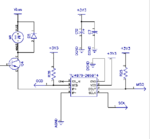Xavier Pacheco Paulino
Junior Member level 1
I'm using this current sensor TLI4970-D050T4 located at the emitter leg of a power IGBT. This transistor is being switched at 10 kHz. How do I choose the convenient sampling frequency for the sensor? My bandwidth is 18 kHz. The IGBT is used in low side switching application to control a DC motor. How fast should I sample the current to get valuable information?
